罗氏E601 电化学发光免疫分析仪双向通讯软件的的开发
罗氏CobasE601全自动电化学发光免疫分析仪检测癌胚抗原(CEA)的研究分析

罗氏Cobas E601全自动电化学发光免疫分析仪检测癌胚抗原(CEA)的研究分析发布时间:2022-11-21T01:39:17.158Z 来源:《医师在线》2022年19期作者:秦英杰[导读] 目的:研究分析罗氏Cobas E601全自动电化学发光免疫分析仪对CEA的检测性能秦英杰锡山人民医院东亭分院江苏无锡 214000【摘要】目的:研究分析罗氏Cobas E601全自动电化学发光免疫分析仪对CEA的检测性能。
方法:从我院2021年1月~2021年6月的体检人员中选择120例,将血液样本作为分析对象,通过罗氏Cobas?E601分析仪对CEA的检测结果进行分析。
结果:在不同浓度、不同批次、批内下,SV(变异系数)结果符合规定范围,检测值在认定范围。
结论:罗氏Cobas?E601全自动电化学发光免疫分析仪对CEA的检测准确性、精密度能够得到保证,值得应用。
【关键词】全自动电化学发光免疫分析仪;癌胚抗原;精密度;准确度【中图分类号】 R446.6 【文献标识码】ACEA属于肿瘤标志物的一种,除了胃癌以外,在乳腺癌、肺癌等癌症中也表现为CEA水平升高。
为此,以CEA指标为基础进行检测能有效判断肿瘤发展程度,利于病情诊断检测[1]。
全自动电化学发光免疫分析仪作为现阶段技术较为成熟的检测仪器,具有处理样本及检测速度快的特点[2]。
为此,本研究将严格按照实验室质量要求,对罗氏Cobas?E601全自动电化学发光免疫分析仪检测性能进行探究分析,现报道内容如下。
1 资料与方法1.1一般资料1.1体检人员资料选择我院2021年1月~2021年6月期间内体检的人员共120名,所有送检的标本均无溶血、无脂血情况,为新鲜标本。
其中,男性体检人员共63例、女性共57例,年龄均值范围:[28~76(48.55±5.13)]岁。
纳入标准:①年龄≥18岁;②自愿参加此研究;③入院基本资料完全。
排除标准:①凝血功能障碍;②妊娠期、哺乳期患者。
罗氏 cobas e 801 电化学发光免疫分析仪使用说明书 - 检测抗 HBs 抗体的试剂盒
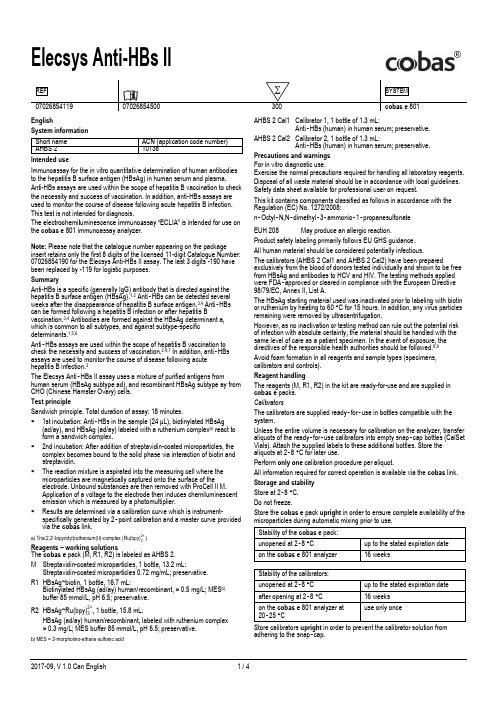
Elecsys Anti-HBs IIREFSYSTEM********************** 300cobas e 801EnglishSystem information Short name ACN (application code number) AHBS 2 10138 Immunoassay for the in vitro quantitative determination of human antibodies to the hepatitis B surface antigen (HBsAg) in human serum and plasma.Anti-HBs assays are used within the scope of hepatitis B vaccination to check the necessity and success of vaccination. In addition, anti-HBs assays are used to monitor the course of disease following acute hepatitis B infection. This test is not intended for diagnosis.The e lectro c hemi l uminescence i mmuno a ssay “ECLIA” is intended for use on the cobas e 801 immunoassay analyzer.Note: Please note that the catalogue number appearing on the package insert retains only the first 8 digits of the licensed 11-digit Catalogue Number: 07026854190 for the Elecsys Anti-HBs II assay. The last 3 digits -190 have been replaced by -119 for logistic purposes. SummaryAnti-HBs is a specific (generally IgG) antibody that is directed against the hepatitis B surface antigen (HBsAg).1,2 Anti ‑HBs can be detected several weeks after the disappearance of hepatitis B surface antigen.3,4 Anti ‑HBs can be formed following a hepatitis B infection or after hepatitis Bvaccination.3,4 Antibodies are formed against the HBsAg determinant a, which is common to all subtypes, and against subtype-specific determinants.1,5,6Anti ‑HBs assays are used within the scope of hepatitis B vaccination to check the necessity and success of vaccination.2,4,7 In addition, anti ‑HBs assays are used to monitor the course of disease following acute hepatitis B infection.3The Elecsys Anti ‑HBs II assay uses a mixture of purified antigens fromhuman serum (HBsAg subtype ad), and recombinant HBsAg subtype ay from CHO (Chinese Hamster Ovary) cells. Test principleSandwich principle. Total duration of assay: 18 minutes.▪ 1st incubation: Anti ‑HBs in the sample (24 μL), biotinylated HBsAg(ad/ay), and HBsAg (ad/ay) labeled with a ruthenium complex a) react to form a sandwich complex.▪ 2nd incubation: After addition of streptavidin-coated microparticles, thecomplex becomes bound to the solid phase via interaction of biotin and streptavidin.▪ The reaction mixture is aspirated into the measuring cell where themicroparticles are magnetically captured onto the surface of the electrode. Unbound substances are then removed with ProCell II M. Application of a voltage to the electrode then induces chemiluminescent emission which is measured by a photomultiplier.▪ Results are determined via a calibration curve which is instrument-specifically generated by 2‑point calibration and a master curve provided via the cobas link.a) Tris(2,2'-bipyridyl)ruthenium(II)-complex (Ru(bpy)32+)Reagents – working solutionsThe cobas e pack (M, R1, R2) is labeled as AHBS 2. M Streptavidin-coated microparticles, 1 bottle, 13.2 mL:Streptavidin-coated microparticles 0.72 mg/mL; preservative. R1 HBsAg~biotin, 1 bottle, 16.7 mL:Biotinylated HBsAg (ad/ay) human/recombinant, > 0.5 mg/L; MES b) buffer 85 mmol/L, pH 6.5; preservative. R2 HBsAg~Ru(bpy)32+, 1 bottle, 15.8 mL:HBsAg (ad/ay) human/recombinant, labeled with ruthenium complex > 0.3 mg/L; MES buffer 85 mmol/L, pH 6.5; preservative.b) MES = 2-morpholino-ethane sulfonic acidAHBS 2 Cal1 Calibrator 1, 1 bottle of 1.3 mL:Anti ‑HBs (human) in human serum; preservative.AHBS 2 Cal2 Calibrator 2, 1 bottle of 1.3 mL:Anti ‑HBs (human) in human serum; preservative.Precautions and warnings For in vitro diagnostic use.Exercise the normal precautions required for handling all laboratory reagents. Disposal of all waste material should be in accordance with local guidelines. Safety data sheet available for professional user on request.This kit contains components classified as follows in accordance with the Regulation (EC) No. 1272/2008:n ‑Octyl ‑N,N ‑dimethyl ‑3‑ammonio ‑1‑propanesulfonateEUH 208 May produce an allergic reaction.Product safety labeling primarily follows EU GHS guidance. All human material should be considered potentially infectious.The calibrators (AHBS 2 Cal1 and AHBS 2 Cal2) have been preparedexclusively from the blood of donors tested individually and shown to be free from HBsAg and antibodies to HCV and HIV. The testing methods applied were FDA ‑approved or cleared in compliance with the European Directive 98/79/EC, Annex II, List A.The HBsAg starting material used was inactivated prior to labeling with biotin or ruthenium by heating to 60 °C for 15 hours. In addition, any virus particles remaining were removed by ultracentrifugation.However, as no inactivation or testing method can rule out the potential risk of infection with absolute certainty, the material should be handled with the same level of care as a patient specimen. In the event of exposure, the directives of the responsible health authorities should be followed.8,9 Avoid foam formation in all reagents and sample types (specimens, calibrators and controls). Reagent handlingThe reagents (M, R1, R2) in the kit are ready-for-use and are supplied in cobas e packs. CalibratorsThe calibrators are supplied ready ‑for ‑use in bottles compatible with the system.Unless the entire volume is necessary for calibration on the analyzer, transfer aliquots of the ready ‑for ‑use calibrators into empty snap ‑cap bottles (CalSet Vials). Attach the supplied labels to these additional bottles. Store the aliquots at 2‑8 °C for later use.Perform only one calibration procedure per aliquot.All information required for correct operation is available via the cobas link. Storage and stability Store at 2‑8 °C. Do not freeze.Store the cobas e pack upright in order to ensure complete availability of the microparticles during automatic mixing prior to use. Stability of the cobas e pack: unopened at 2‑8 °Cup to the stated expiration date on the cobas e 801 analyzer 16 weeksStability of the calibrators: unopened at 2‑8 °C up to the stated expiration date after opening at 2‑8 °C 16 weeks on the cobas e 801 analyzer at 20‑25 °Cuse only onceadhering to the snap ‑cap.Specimen collection and preparationOnly the specimens listed below were tested and found acceptable.Serum collected using standard sampling tubes or tubes containing separating gel.K2‑EDTA and K3‑EDTA plasma.Criterion: Slope 1.00 ± 0.15 + intercept 0 ± 2 IU/L + bias at 10 IU/L: ≤ 30 %. Stable for 3 days at 20‑25 °C, 6 days at 2‑8 °C, 3 months at ‑20 °C(± 5 °C). The samples may be frozen 5 times.For plasma treated with lithium heparin, lithium heparin with gel or sodium heparin, the values found were on average up to 20 % lower than those obtained in serum. For plasma treated with sodium citrate, the values found were on average up to 30 % lower than those obtained with serum.The sample types listed were tested with a selection of sample collection tubes or systems that were commercially available at the time of testing, i.e. not all available tubes of all manufacturers were tested. Sample collection systems from various manufacturers may contain differing materials which could affect the test results in some cases. When processing samples in primary tubes (sample collection systems), follow the instructions of the tube manufacturer.Centrifuge samples containing precipitates and thawed samples before performing the assay.Do not use heat‑inactivated samples.Do not use samples and controls stabilized with azide.Ensure the samples and calibrators are at 20‑25 °C prior to measurement. Due to possible evaporation effects, samples and calibrators on the analyzers should be analyzed/measured within 2 hours.The performance of the Elecsys Anti‑HBs II assay has not been established with cadaveric samples or body fluids other than serum and plasma. Materials providedSee “Reagents –working solutions” section for reagents.▪ 2 x 6 bottle labelsMaterials required (but not provided)▪REF 11876317122, PreciControl Anti‑HBs, 16 x 1.3 mL▪REF 11776576322, CalSet Vials, 2 x 56 empty snap-cap bottles▪REF***********,DiluentUniversal,45.2mLsamplediluent▪▪cobas e 801 analyzerAccessories for the cobas e 801 analyzer:▪REF***********,ProCellIIM,2x2Lsystemsolution▪REF 04880293190, CleanCell M, 2 x 2 L measuring cell cleaning solution ▪REF***********,ReservoirCups,8cupstosupplyProCellIIMand CleanCell M▪REF***********,PreCleanIIM,2x2Lwashsolution▪REF***********,AssayTip/AssayCuptray,6magazinesx6magazine stacks x 105 assay tips and 105 assay cups, 3 wasteliners▪REF***********,LiquidFlowCleaningCup,2adaptorcupstosupply ISE Cleaning Solution/Elecsys SysClean for Liquid Flow CleaningDetection Unit▪REF***********,PreWashLiquidFlowCleaningCup,1adaptorcupto supply ISE Cleaning Solution/Elecsys SysClean for Liquid Flow Cleaning PreWash Unit▪REF 11298500316, ISE Cleaning Solution/Elecsys SysClean,5 x 100 mL system cleaning solutionAssayFor optimum performance of the assay follow the directions given in this document for the analyzer concerned. Refer to the appropriate operator’s manual for analyzer‑specific assay instructions.Resuspension of the microparticles takes place automatically prior to use. Place the cooled (stored at 2‑8 °C) cobas e pack on the reagent manager. Avoid foam formation. The system automatically regulates the temperature of the reagents and the opening/closing of the cobas e pack. Calibrators:Place the calibrators in the sample zone.Read in all the information necessary for calibrating the assay.CalibrationTraceability: This method has been standardized against the 1st WHO Reference Standard 1977.The predefined master curve is adapted to the analyzer using AHBS 2 Cal1 and AHBS 2 Cal2.Calibration frequency: Calibration must be performed once per reagent lot using AHBS 2 Cal1, AHBS 2 Cal2 and fresh reagent (i.e. not more than24 hours since the reagent kit was registered on the analyzer).Renewed calibration is recommended as follows:▪after 12 weeks when using the same reagent lot▪after 28 days when using the same cobas e pack on the analyzer▪as required: e.g. quality control findings with PreciControl Anti‑HBs outside the defined limitsQuality controlFor quality control, use PreciControl Anti‑HBs.Controls for the various concentration ranges should be run individually at least once every 24 hours when the test is in use, once per cobas e pack, and following each calibration.The control intervals and limits should be adapted to each laboratory’s individual requirements. Values obtained should fall within the defined limits. Each laboratory should establish corrective measures to be taken if values fall outside the defined limits.If necessary, repeat the measurement of the samples concerned.Follow the applicable government regulations and local guidelines for quality control.CalculationThe analyzer automatically calculates the analyte concentration of each sample in IU/L.Interpretation of the resultsNumeric result Result message Interpretation< 10 IU/L Non-reactive Negative for anti-HBs≥ 10 IU/L Reactive Positive for anti-HBsvary depending on the testing procedure used. Results obtained from a single sample using tests from different manufacturers can therefore differ by up to a factor of 4 (or even a factor of 10 in rare cases). If there is a change in the assay procedure used during the monitoring of vaccination protection, then the anti‑HBs values obtained upon changing over to the new method must be confirmed by parallel measurements by both methods. Vaccination strategies in certain risk groups are based on the measured anti‑HBs concentration. Respective recommendations are given by national or regional guidelines. Limitations - interferenceThe effect of the following endogenous substances and pharmaceutical compounds on assay performance was tested. Interferences were tested up to the listed concentrations and no impact on results was observed. Endogenous substancesCompound Concentration testedBilirubin ≤ 513 μmol/L or ≤ 30 mg/dL Hemoglobin ≤ 0.621 mmol/L or ≤ 1000 mg/dL Intralipid ≤ 1500 mg/dLBiotin ≤ 41 nmol/L or ≤ 10 ng/mL Rheumatoid factors ≤ 1200 IU/mLAlbumin ≤ 7.0 g/dLIgG ≤ 7.0 g/dLIgA ≤ 1.6 g/dLIgM ≤ 1.0 g/dL2 / 42017-09, V 1.0 Can EnglishCriterion: Recovery for samples from Limit of Detection to 10 IU/L:≤ ± 2 IU/L, and samples > 10 IU/L: ≤ ± 20 % of initial value.Samples should not be taken from patients receiving therapy with high biotin doses (i.e. > 5 mg/day) until at least 8 hours following the last biotin administration.Pharmaceutical substancesIn vitro tests were performed on 16 commonly used pharmaceuticals. No interference with the assay was found.In addition, the following special drugs used in hepatitis B therapy were tested. No interference with the assay was found.Special drugsDrug Concentration testedmg/LPeginterferon alfa‑2a ≤ 0.18Peginterferon alfa‑2b ≤ 1.6Lamivudine ≤ 300Adefovir ≤ 10Entecavir ≤ 10Tenofovir ≤ 600Telbivudine ≤ 245Due to high-dose hook effect c), results from anti‑HBs concentrations of> 200000 IU/L may be found below the upper limit of the measuring range of 1000 IU/L. In rare cases, a high-dose hook effect from anti HBs concentrations of < 20000 IU/L cannot be excluded. Therefore in case of any unexpected low result the sample should be diluted 1:100 (refer to chapter “Dilution”) and tested again.In rare cases, interference due to extremely high titers of antibodies to streptavidin and ruthenium can occur. The test contains additives which minimize these effects.c) High-dose hook effect: A sample with a true concentration clearly above the measuring range, but found within the measuring range.Limits and rangesMeasuring range2‑1000 IU/L (defined by the Limit of Detection and the maximum of the master curve). Values below the Limit of Detection are reported as< 2 IU/L.Values above the measuring range are reported as > 1000 IU/L (or up to 100000 IU/L for 100‑fold diluted samples).DilutionSamples with anti‑HBs concentrations above the measuring range can be diluted with Diluent Universal. The recommended dilution is 1:100 (either automatically by the analyzer or manually). The concentration of the diluted sample must be > 10 IU/L.After manual dilution, multiply the result by the dilution factor.After dilution by the analyzer, the software automatically takes the dilution into account when calculating the sample concentration.Manual dilution can also be made with negative human serum.Note: Antibodies to HBsAg are heterogeneous. In some isolated cases, this may lead to non-linear dilution behavior.Specific performance dataRepresentative performance data on the analyzer is given below. Results obtained in individual laboratories may differ.PrecisionPrecision was determined using Elecsys reagents, samples and controls in a protocol (EP05‑A3) of the CLSI (Clinical and Laboratory Standards Institute): 2 runs per day in duplicate each for 21 days (n = 84). The following results were obtained:cobas e 801 analyzerRepeatability d)Intermediateprecision e)Sample MeanIU/LSDIU/LCV%SDIU/LCV% Human serum 1 4.33 0.224 5.2 0.272 6.3 Human serum 2 12.0 0.237 2.0 0.277 2.3 Human serum 3 475 6.81 1.4 7.55 1.6 PC f) Anti-HBs 1 < 2.00 - - - -PC Anti-HBs 2 83.8 1.08 1.3 1.28 1.5d) Repeatability = within-run precisione) Intermediate precision = between-run precisionf) PC = PreciControlAnalytical specificityNo cross-reactions with HAV, HCV, HEV, CMV, EBV, HIV, Rubella, Toxoplasma gondii, Treponema pallidum, rheumatoid arthritis, autoimmune response or alcoholic liver disease were observed.Measurements were performed on each of the pathogens listed above using ≥ 8 serum or plasma samples which were positive for antibodies to the above-mentioned pathogens.Relative sensitivityPerformance of the Elecsys Anti‑HBs II assay has been assessed by testing a total of 669 samples at two different study sites. 296 samples from vaccinated persons and 373 samples from patients recovered from a hepatitis B infection have been measured with the Elecsys Anti‑HBs II assay and another commercially available fully automated anti‑HBs assay. Discrepant samples were tested with additional anti‑HBs assays to achieve a consensus.Characterization ofsamplesN ElecsysAnti‑HBs IIreactiveAnti‑HBscomparisontest reactiveSensitivity%Anti-HBs positive:vaccinees 296 296 296 100Anti-HBs positive:recovered from ahepatitis B infection373 373 373 100 Total 669 669 669 100 Relative specificityPerformance of the Elecsys Anti‑HBs II assay has been assessed by testing 2673 samples from blood donors negative for anti‑HBs at two different study sites and 1623 anti‑HBs negative samples from laboratory routine at three different study sites. Discrepant samples were tested with additional anti‑HBs assays to achieve a consensus.Characterization of samples N ElecsysAnti‑HBs IIfalsepositiveSpecificity%Anti-HBs negative: blood donors 2673 6 99.78 Anti-HBs negative: routinesamples1623 9 99.45 References1Seeger C, Zoulim F, Mason WS. Hepadnaviruses. In: Field’s Virology, Knipe DM, Howley RM (eds), 2007 5th edition, Lippincott Williams andWilkins, Philadelphia, USA. Chapter 76, pp2977-3029.2WHO. Hepatitis B vaccines. Wkly Epidemiol Rec 2009;84:405-420.3Liaw YF, Chu CM. Hepatitis B virus infection. Lancet2009;373:582-592.4Caspari G, Gerlich WH. The serologic markers of hepatitis B virus infection – proper selection and standardized interpretation. Clin Lab2007;53:335-343.5Kramvis A, Kew M, François G. Hepatitis B virus genotypes. Vaccine 2005;23:2409-2423.6Michel ML, Tiollais P. Hepatitis B vaccines: protective efficacy and therapeutic potential. Pathol Biol 2010;58:288-295.7Elgouhari HM, Abu-Rajab Tamimi TI, Carey WD. Hepatitis B virus infection: understanding its epidemiology, course, and diagnosis. Cleve Clin J Med 2008;75:881-889.8Occupational Safety and Health Standards: Bloodborne pathogens. (29 CFR Part 1910.1030). Fed. Register.9Directive 2000/54/EC of the European Parliament and Council of18 September 2000 on the protection of workers from risks related toexposure to biological agents at workFor further information, please refer to the appropriate operator’s manual for the analyzer concerned, the respective application sheets, the product information and the Method Sheets of all necessary components (if available in your country).A point (period/stop) is always used in this Method Sheet as the decimal separator to mark the border between the integral and the fractional parts of a decimal numeral. Separators for thousands are not used.SymbolsRoche Diagnostics uses the following symbols and signs in addition to those listed in the ISO 15223‑1 standard:CONTENT Contents of kitSYSTEM Analyzers/Instruments on which reagents can be used REAGENT ReagentCALIBRATOR CalibratorVolume after reconstitution or mixingGTIN Global Trade Item NumberCOBAS, COBAS E, ELECSYS and PRECICONTROL are trademarks of Roche. INTRALIPID is a trademark of Fresenius Kabi AB.All other product names and trademarks are the property of their respective owners. Additions, deletions or changes are indicated by a change bar in the margin.© 2016, Roche DiagnosticsRoche Diagnostics GmbH, Sandhofer Strasse 116, D-68305 Mannheim。
Roche E601全自动电化学发光仪日常使用、维护与保养
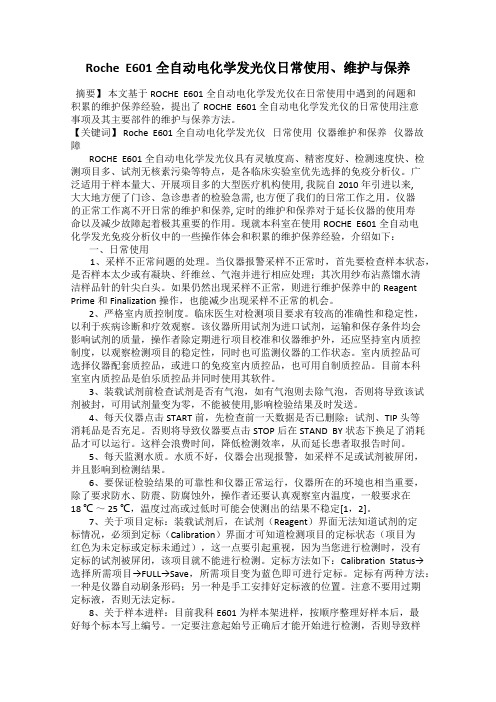
Roche E601全自动电化学发光仪日常使用、维护与保养摘要】本文基于ROCHE E601全自动电化学发光仪在日常使用中遇到的问题和积累的维护保养经验,提出了ROCHE E601全自动电化学发光仪的日常使用注意事项及其主要部件的维护与保养方法。
【关键词】 Roche E601全自动电化学发光仪日常使用仪器维护和保养仪器故障ROCHE E601全自动电化学发光仪具有灵敏度高、精密度好、检测速度快、检测项目多、试剂无核素污染等特点,是各临床实验室优先选择的免疫分析仪。
广泛适用于样本量大、开展项目多的大型医疗机构使用, 我院自2010年引进以来,大大地方便了门诊、急诊患者的检验急需, 也方便了我们的日常工作之用。
仪器的正常工作离不开日常的维护和保养, 定时的维护和保养对于延长仪器的使用寿命以及减少故障起着极其重要的作用。
现就本科室在使用ROCHE E601全自动电化学发光免疫分析仪中的一些操作体会和积累的维护保养经验,介绍如下:一、日常使用1、采样不正常问题的处理。
当仪器报警采样不正常时,首先要检查样本状态,是否样本太少或有凝块、纤维丝、气泡并进行相应处理;其次用纱布沾蒸馏水清洁样品针的针尖白头。
如果仍然出现采样不正常,则进行维护保养中的Reagent Prime和Finalization操作,也能减少出现采样不正常的机会。
2、严格室内质控制度。
临床医生对检测项目要求有较高的准确性和稳定性,以利于疾病诊断和疗效观察。
该仪器所用试剂为进口试剂,运输和保存条件均会影响试剂的质量,操作者除定期进行项目校准和仪器维护外,还应坚持室内质控制度,以观察检测项目的稳定性,同时也可监测仪器的工作状态。
室内质控品可选择仪器配套质控品,或进口的免疫室内质控品,也可用自制质控品。
目前本科室室内质控品是伯乐质控品并同时使用其软件。
3、装载试剂前检查试剂是否有气泡,如有气泡则去除气泡,否则将导致该试剂被封,可用试剂量变为零,不能被使用,影响检验结果及时发送。
罗氏电化学发光项目介绍
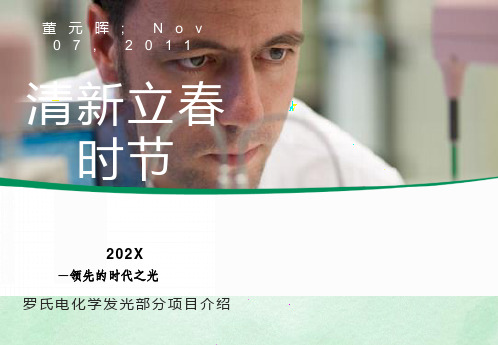
E2
Testo
Prog
LH
FSH
Prolactin
SHBG
CEA
fPSA
PSA
ßXlaps
Osteocalcin
PTH
bio-int. PTH
Vit D3
Vit D2/D3
P1NP
CA19-9
CA125
CA15-3
CA72-4
CYFRA
NSE
S100
GF-AP
anti-CCP
PCT
IL-6
IgE
Ferritin
B12
Folate
RBC Fol
Hepcidin
hCG+ß
AFP
fßhCG
PAPP-A
uE3
Inhibin A
hCG STAT
PlGF
sFLT1
TSH
FT4
FT3
T4
T3
T-uptake
TnT
hsTnT
TnI
Myoglobin
CK-MB
Cyclosp. A
Tacrolimus
Sirolimus
创始人
1926年进入中国
南京路上的办事处
江泽民参观罗氏总部
罗氏集团的两大事业部门
药品事业部 诊断事业部
罗氏集团架构
诊断
健康医护部
应用科学部
制药
制药
中外
基因泰克
专业诊断部
分子诊断部
组织诊断部
罗氏诊断覆盖领域
ER/ICU: Emergency Room, Intensive Care Unit
病人
04
Part
其他项目简介
罗氏Cobas e601全自动免疫分析仪检测人附睾蛋白4(HE4)的性能验证

罗氏Cobas e601全自动免疫分析仪检测人附睾蛋白4(HE4)的性能验证目的验证和评价罗氏Cobas e601全自动免疫分析仪检测系统人附睾蛋白4项目的分析性能。
方法参考美国临床实验室标准化协会(CLSI)系列文件和相关文献,对罗氏Cobas e601电化学发光免疫检测系统测定血清人附睾蛋白4(HE4)的精密度、准确度、分析灵敏度、分析测量范围、生物参考区间5大分析性能进行验证和评价,并将实验结果与厂商声明的性能或公认的质量标准进行比较。
结果测定均值为100.66pmol/L的质控样本,验证后S批内为0.827 ,S 总为1.679;测定均值为1296.60pmol/L的质控样本,验证后S批内为6.077,S 总为5.596 。
S批内≤1/4TEa,S总≤1/3TEa(CLIA’88)。
准确度在±1%以内,低于卫生部允许的偏差范围;分析灵敏度0.975,线性理想。
实测线性范围60.65pmol/L~1364.50 pmol/L;试剂盒线性范围15pmol/L~1500 pmol/L,符合性能要求(见表4)。
2.5 生物参考区间验证结果Roche公司提供的参考区间为0.00pmol/L~104.00 pmol/L ,20个健康人血清标本浓度范围32.04pmol/L~67.05 pmol/L,验证结果均在仪器说明的参考区间内,提示该95%生物参考区间可以接受。
3 讨论人附睾上皮分泌蛋白4(human epididymis protein,HE4)是近年来研究较热门的一种新型肿瘤标志物,并拟在中国临床上推广应用。
HE4属于乳清酸性4-二硫化中心(WFDC)蛋白家族[1],具有疑似胰蛋白酶抑制剂的特性。
此家族中的其它蛋白还包括SLPI,Elafin和PS20(WFDC1)。
HE4基因编码一段长度为13kD的蛋白,包括含有两个WFDC结构域的一条单链[2]。
卵巢癌是全世界范围内导致女性癌症相关死亡中的第四大常见原因,分泌型HE4在卵巢癌患者的血清中有高水平表達[3],HE4检测用于监测上皮卵巢癌疾病复发或进展。
罗氏Cobas6000全自动电化学发光免疫分析仪条码双工的设置与应用
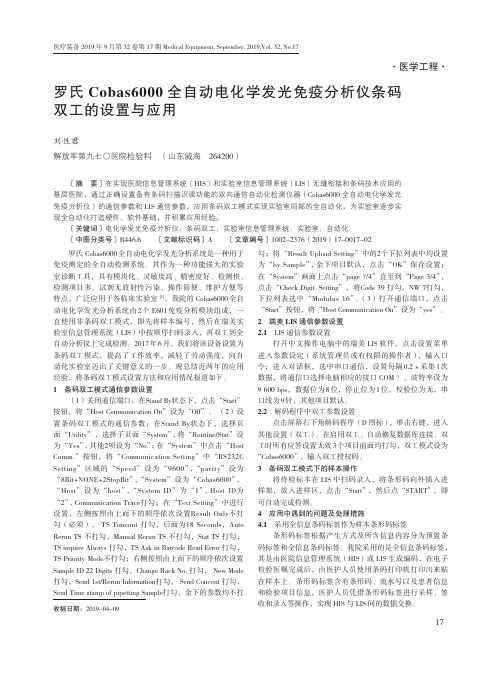
罗氏Cobas6000全自动电化学发光分析系统是一种用于免疫测定的全自动检测系统。
其作为一种功能强大的实验室诊断工具,具有模块化、灵敏度高、精密度好、检测快、检测项目多、试剂无放射性污染、操作简便、维护方便等特点,广泛应用于各临床实验室[1]。
我院的Cobas6000全自动电化学发光分析系统由2个E601免疫分析模块组成,一直使用非条码双工模式,即先将样本编号,然后在瑞美实验室信息管理系统(LIS)中按顺序扫码录入,再双工到全自动分析仪上完成检测。
2017年6月,我们将该设备设置为条码双工模式,提高了工作效率,减轻了劳动强度,向自动化实验室迈出了关键意义的一步。
现总结近两年的应用经验,将条码双工模式设置方法和应用情况报道如下。
1 条码双工模式通信参数设置(1)关闭通信端口:在Stand By状态下,点击“Start”按钮,将“Host Communication On”设为“Off”。
(2)设置条码双工模式的通信参数:在Stand By状态下,选择页面“Utility”,选择子页面“System”,将“Routine/Stat”设为“Yes”,其他2项设为“No”;在“System”中点击“Host Comm.”按钮,将“Communication Setting”中“RS232C Setting”区域的“Speed”设为“9600”,“parity”设为“8Bit+NONE+2StopBit”,“System”设为“Cobas6000”,“Host”设为“host”,“System ID”为“1”,Host ID为“2”,Communication Trace打勾;在“Text Setting”中进行设置,左侧按照由上而下的顺序依次设置Result Only不打勾(必须), TS Timeout 打勾,后面为18 Seconds,Auto Rerun TS 不打勾,Manual Rerun TS 不打勾,Stat TS 打勾, TS inquire Always 打勾,TS Ask in Barcode Read Error 打勾,TS Priority Mode不打勾;右侧按照由上而下的顺序依次设置Sample ID 22 Digits 打勾,Change Rack No. 打勾, New Mode 打勾,Send 1st/Rerun Information打勾, Send Concent 打勾,Send Time stamp of pipetting Sample打勾,余下的参数均不打勾;将“Result Upload Setting”中的2个下拉列表中均设置为“by Sample”,余下项目默认,点击“OK”保存设置;在“System”画面上点击“page ?/4”直至到“Page 3/4”,点击“Check Digit Setting”,将Code 39 打勾,NW 7打勾,下拉列表选中“Modulus 16”。
罗氏电化学发光仪器E-SOP

罗氏电化学发光仪器E-SOP————————————————————————————————作者:————————————————————————————————日期:2罗氏电化学发光仪器E170 SOP仪器简介:E170 是罗氏诊断公司出品的全自动电化学发光免疫分析仪,是全自动,随机进样的免疫分析系统,可以对许多种检测项目进行体外的定量或者定性的分析。
该分析仪应用的是电化学发光技术(ECL)。
每个E模块系统每小时的标本处理量为170个试验(最多可以将4个E模块连接)。
只有在试验室条件下,经过培训的操作者方可操作E模块系统。
系统特色∙可以24小时待机使用∙标本条码扫描功能∙试剂条码扫描功能∙单个E模块的每小时处理能力为170个试验∙自动保养功能∙自动复查功能∙自动发出定标信息∙自动标本稀释功能∙系统辅助的操作流程∙一个E模块具有25个温控的试剂通道∙1个模块可以安放672个反应杯∙1个模块可以安放672个加样头∙双向数据传输接口运行条件:水质要求◆无菌(< 10 cfu/ml),去离子水◆ 1.5 MΩ电阻值(最大1.0 Ms/cm)3◆15-25 磅/英寸2 (0.5~3.5 kg/cm2 或49~343 kpa)◆耗水量:每E170模块消耗18升/小时环境条件◆无灰尘的、良好通风的环境◆无直接日照◆地面水平(角度:<1/200 º)◆地面足够坚硬能够承受仪器的重量(详细情况请见本章中的系统特点)◆温度:18~32摄氏度◆当系统启动时,温度的改变应该小于2度/小时◆屋内湿度:45%~85%◆电源电压没有明显的波动◆在附近没有会产生电磁波的仪器◆有接地的三相电源E170由三个类型的硬件单元组成:控制单元、核心单元以及检测单元。
控制单元介绍包括:∙触摸屏幕的电脑∙键盘∙打印机∙仪器管理电脑终端4核心单元介绍核心单元将所有的标本从入口端经过E170仪器到出口端或者复查缓冲区。
下面所列位核心单元的组成部分。
罗氏E601电化学发光免疫分析仪用户操作手册(中文)
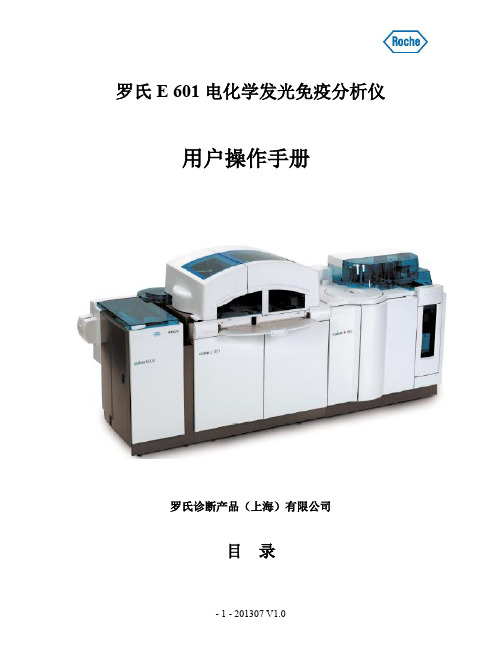
第六章 仪器报警信息......................................................................... .. 51
- 2 - 201307 V1.0
第一章 系统概述
1、 控制单元
A 显示器(连接cobas link) B 键盘/鼠标(连接cobas link) C 计算机(连接cobas link) G 人体学PC支架
第四章 维护保养 1、每日保养 ......................................................................... ................ 46 2、每周保养 ......................................................................... .................46 3、每两周保养 ......................................................................... ............. 48 4、每季保养 ......................................................................... ................ 49 5、按需保养 ......................................................................... ................ 49
cobas-e-601电化学发光免疫分析仪

cobas-e-601电化学发光免疫分析仪第一章系统概述1、控制单元A 显示器(连接cobas ) D 触摸式显示器(主机)B 键盘/鼠标(连接cobas) E 键盘/鼠标(主机)C 计算机(连接cobas) F 计算机(主机)G 人体学PC支架- 1 -2、核心单元1)核心单元轨道A 核心单元E 模块轨道B 急诊标本位F 常规标本上机位- 2 -C 条形码阅读器G 标本退出位D 标本架转盘急诊标本位- 3 -A 标本架托盘B 标本架C 标本杯、微量杯2)标本架及标本容器标本架不同类型、颜色和相应编号如下:标本架类型标本架颜色标本架ID号软件中显示标本架上标签常规标本架灰色5001-8999 001-3999001-3999STAT标本架红色4001-4999E001-E999S001-S999定标标本架黑色2001-2999 S001-S999C001-C999QC标本架白色3001-3999 C001-C999Q001-Q999保养标本架绿色B999 B999 W999标本容器有三种类型:标本试管、标本杯、定标及质控小瓶- 4 -标本试管直径为13mm或16mm,长度为75mm或100mm;标本杯可插入16 mm标本试管中用。
A 标本架上的标本杯 D 16mm×100mm试管B 16mm×75mm试管 E 16mm×100mm试管上的标本杯C 16mm×75mm试管上标本杯3、cobas e 601免疫分析模块- 5 -e 601模块主要部件如下:A 预清洗区 C 测量区 E 系统试剂区(在前门后面)B 试剂区 D 耗品区B 试剂区各部件- 6 -A 试剂盘 D 磁珠搅拌棒 F 试剂针B 条件码阅读器 E 磁珠搅拌棒冲洗站 G 试剂针冲洗站C 试剂盖开/关 H 探针清洗站I 试剂注射器- 7 -C 测量区各部件A 标本针 E 标本注射器B 孵育盘 F sipper注射器C sipper针D sipper冲洗站- 8 -D 耗品区A 抓手 E TIP/CUP 盒升降器B 涡流混合站 F TIP/CUP 丢弃袋C TIP/CUP G TIP/CUP 盒丢弃区D 指示灯指示器灯“亮”时抽屉可安全打开指示器灯“灭”时抽屉严禁打开- 9 -E 系统试剂区PrecleanProcellcleancel当更换三种系统试剂的任一种时,长按相对应的绿色按键第二章 软件系统简介1、系统状态概览日常保养 数据清除 试剂准备 定标质控选择 参数下载 标本运行状态仪器 各部件 温度报警试剂查看2、日常工作菜单工作区试剂定标质控应用设定停止关机停止吸样报警系统状态概览仪器状态操作者日期时间第三章基本操作1、开机a 、检查供水、排水系统是否正常,打开供水系统电源b 、接通仪器左侧电源开关A 标本架上机/退出区 C 电源开关B 急诊标本位 D 主开关电路断路器c 、登陆输入用户名及密码,仪器初始化后进入Stand by 状态注意:仪器分不同级别及权限使用,可根据实际情况设定;添加用户名后,第一次输入的密码即为以后的密码。
E601 电化学发光免疫分析仪性能验证报告
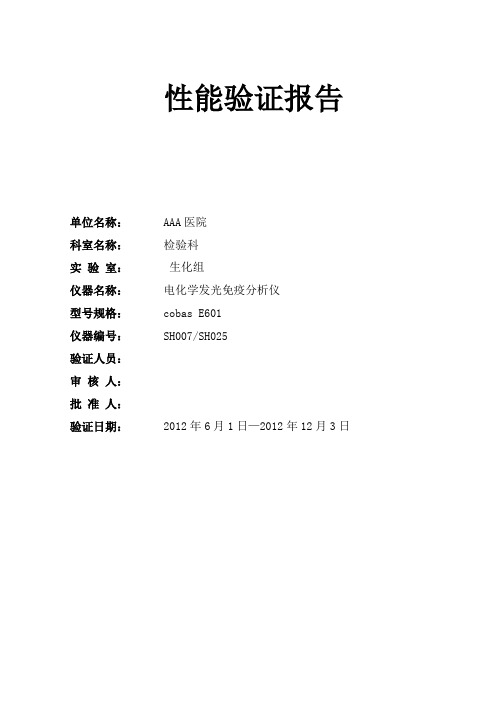
性能验证报告单位名称:AAA医院科室名称:检验科实验室:生化组仪器名称:电化学发光免疫分析仪型号规格:cobas E601仪器编号:SH007/SH025验证人员:审核人:批准人:验证日期:2012年6月1日—2012年12月3日目录β人绒毛膜促性腺激素(β-HCG)方法学验证 (1)皮质醇方法学验证 (7)雌二醇(E2)方法学验证 (12)卵泡刺激素(FSH)方法学验证 (17)促黄体生成素(LH)方法学验证 (21)泌乳素(PRL)方法学验证 (26)孕酮(P)方法学验证 (31)睾酮(T)方法学验证 (36)乙型肝炎病毒核心抗体(抗HBc)定量方法学验证 (41)乙型肝炎病毒e抗体(HBeAb)定量方法学验证 (47)乙型肝炎病毒e抗原(HBeAg)定量方法学验证 (53)乙型肝炎病毒表面抗体(抗HBs)定量方法学验证 (59)乙型肝炎病毒表面抗原(HBsAg)定量方法学验证 (66)甲胎蛋白(AFP)方法学验证 (72)糖类抗原CA-125方法学验证 (78)糖类抗原CA-153方法学验证 (84)糖类抗原CA-199方法学验证 (90)癌胚抗原(CEA)方法学验证 (96)游离前列腺特异性抗原(FPSA)方法学验证 (102)总前列腺特异性抗原(TPSA)方法学验证 (108)β人绒毛膜促性腺激素(β-HCG)方法学验证一.检测系统信息:●项目:β-HCG●仪器名称:罗氏电化学发光免疫分析仪●仪器型号: cobas E601●试剂及厂商:罗氏公司校准品和试剂●检测方法:电化学发光二.厂商的相关参数:需验证参数厂商参数验证结果分析灵敏度(lowerdetectionlimit)0.1 mIU /mL 沿用厂商参数分析测量范围(AMR)0.100-10000 mIU/mL 通过实验进行验证临床报告范围(CRR)0.100-1000000 mIU/mL 根据厂家相关参数换算而来参考值区间(Expected values) 0-10mIU/mL 通过实验进行验证1/4卫生部临检中心室间质评最大允许误差,批间精密度<1/3卫生部临检中心室间质评最大允许误差。
罗氏cobas-e601化学发光免疫分析仪标准操作程序
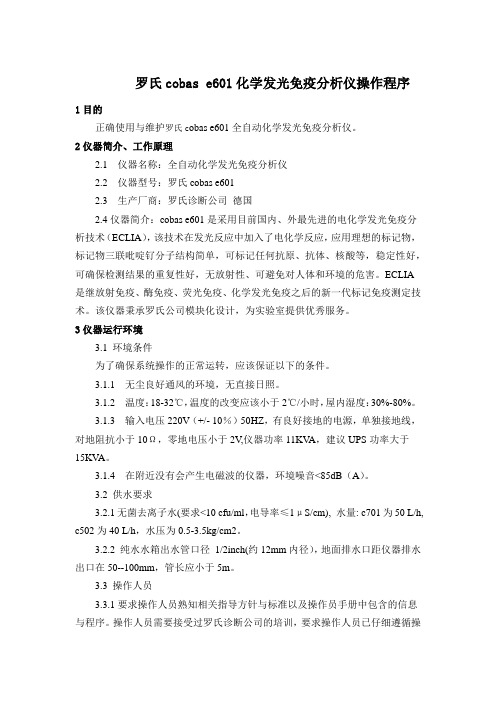
罗氏cobas e601化学发光免疫分析仪操作程序1目的正确使用与维护罗氏c obas e601全自动化学发光免疫分析仪。
2仪器简介、工作原理2.1 仪器名称:全自动化学发光免疫分析仪2.2 仪器型号:罗氏cobas e6012.3 生产厂商:罗氏诊断公司德国2.4仪器简介:cobas e601是采用目前国内、外最先进的电化学发光免疫分析技术(ECLIA),该技术在发光反应中加入了电化学反应,应用理想的标记物,标记物三联吡啶钌分子结构简单,可标记任何抗原、抗体、核酸等,稳定性好,可确保检测结果的重复性好,无放射性、可避免对人体和环境的危害。
ECLIA是继放射免疫、酶免疫、荧光免疫、化学发光免疫之后的新一代标记免疫测定技术。
该仪器秉承罗氏公司模块化设计,为实验室提供优秀服务。
3仪器运行环境3.1 环境条件为了确保系统操作的正常运转,应该保证以下的条件。
3.1.1 无尘良好通风的环境,无直接日照。
3.1.2 温度:18-32℃,温度的改变应该小于2℃/小时,屋内湿度:30%-80%。
3.1.3 输入电压220V(+/- 10%)50HZ,有良好接地的电源,单独接地线,对地阻抗小于10Ω,零地电压小于2V,仪器功率11KV A,建议UPS功率大于15KV A。
3.1.4 在附近没有会产生电磁波的仪器,环境噪音<85dB(A)。
3.2 供水要求3.2.1无菌去离子水(要求<10 cfu/ml,电导率≤1μS/cm), 水量: c701为50 L/h, c502为40 L/h,水压为0.5-3.5kg/cm2。
3.2.2 纯水水箱出水管口径1/2inch(约12mm内径),地面排水口距仪器排水出口在50--100mm,管长应小于5m。
3.3 操作人员3.3.1要求操作人员熟知相关指导方针与标准以及操作员手册中包含的信息与程序。
操作人员需要接受过罗氏诊断公司的培训,要求操作人员已仔细遵循操作员手册中详细说明的系统操作与维护程序,并取得罗氏公司培训合格的证书。
罗氏电化学发光原理

双抗夹心法 & 桥联免疫法
Sandwich Principle
双抗夹心法
large molecular weight antigens are measured
directly proportional measurement, means: low signal = low concentration high signal = high concentration e.g. TSH, CA 15-3 II – assays
e.g. T4, Folate II – assays
电化学发光免疫系统核心原理
✓电化学发光 ✓磁性微粒子固相 ✓亲和素- 生物素间接包被 ✓流动池检测系统 ✓简单试剂管理,先进的定标概念
磁性微粒子固相载体的优点
•直径最小– 2.8um •表面积大而均一 •磁性微粒子呈悬浮状态 •使异相反应变成类均相反应 •加快反应速度 •提高反应灵敏度
A N T IG E N
B IO T IN Y L A T E D A N T IG E N
R U T H E N IU M L A B E L L E D A N T IB O D Y
S T R E P T A V ID IN -C O A T E D M IC R O P A R T IC L E
电化学发光免疫分析原理
杨明忠 12/2014
• 免疫检测技术的发展 • 电化学发光系统及其原理 • 电化学发光技术的优势
• 免疫检测技术的发展 • 电化学发光系统及其原理 • 电化学发光技术的优势
技术创新领先的免疫检测新技术-ECL
电化学发光
放免
酶免 荧光免疫 化学发光
1960‘S 1970~80‘S
cobas e 601电化学发光免疫分析仪
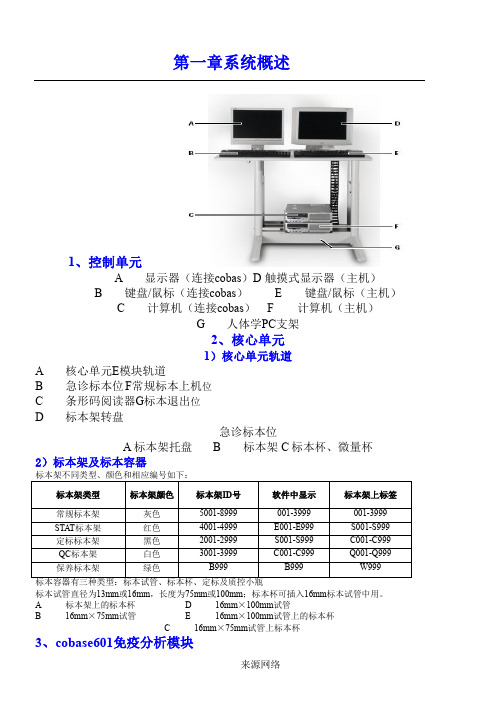
第一章系统概述、控制单元标本试管直径为13mm或16mm,长度为75mm或100mm;标本杯可插入16mm标本试管中用。
A 标本架上的标本杯 D 16mm×100mm试管B 16mm×75mm试管 E 16mm×100mm试管上的标本杯C 16mm×75mm试管上标本杯3、cobase601免疫分析模块e601模块主要部件如下:A预清洗区C测量区E系统试剂区(在前门后面)B试剂区D耗品区B试剂区各部件A试剂盘D磁珠搅拌棒F试剂针B条件码阅读器E磁珠搅拌棒冲洗站G试剂针冲洗站C试剂盖开/关H探针清洗站I试剂注射器C 测量区各部件A 标本针E 标本注射器B 孵育盘Fsipper 注射器 Csipper 针 Dsipper 冲洗站D 耗品区A 抓手ETIP/CUP 盒升降器B 涡流混合站FTIP/CUP 丢弃袋 CTIP/CUPGTIP/CUP 盒丢弃区 D 指示灯E 系统试剂区2、日常工作菜单仪器各部件 温度 打印预览报警试剂查看取消保养 工作区试剂定标质控应用设定START------HostSetting------Change,将CommunicationOn打上勾,点OK。
8、每周应对系统数据进行备份:仪器处于Standby状态,将格式化后的3.5寸软盘插入软驱,进入Utility----Maintenance------Floppydiskutility(14,格式化)-----ParameterRead/Write(15)------Select------WriteFloppyDisk------Execute,完成后将软盘取出。
a 29)——b 用消杯,完成后对仪器进行复位,接着进行灌注Utility ——Maintenance ——ReagentPrime(选择E 模块及灌注试剂、次数,完成后进行关机保养Utility —— Maintenance ——Finalization ,选定E 模块及测量池1、2,完成后仪器回到StandByb 、清洁搅拌棒、混匀器、孵育池等:Utility ——Maintenance ——ManualCleaning (29)——Select ,选择E 模块,点Execute ,先用蘸70%酒精的干净纱布擦拭,再用蘸蒸馏水的干净纱布擦拭,,最后用干净纱布擦拭,完成后点Stop ,最后对整台仪器进行复位,Utility ——Maintenance ——Reset(1)。
罗氏 E 601 电化学发光免疫分析仪 用户操作手册(英文)
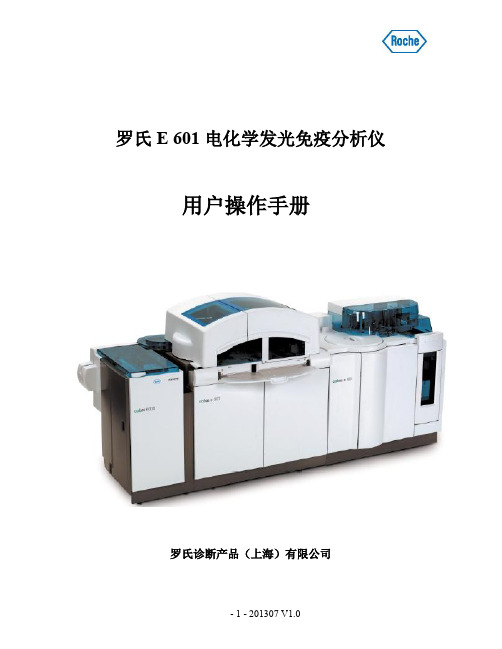
罗氏E 601 电化学发光免疫分析仪用户操作手册罗氏诊断产品(上海)有限公司目录第一章系统概述1、控制单元......................................................................... .. (3)2、核心单元......................................................................... (4)3、cobas e601免疫分析模块..................................................... .. . .. (5)第二章软件系统简介1、系统状态概览......................................................................... .. (7)2、日常工作菜单......................................................................... .. (12)第三章常规操作1、开机......................................................................... ................ .. (14)2、仪器准备......................................................................... . (15)3、增加新项目......................................................................... . (16)4、增加校准品........................................... ........ ...... .... ... ..... ..... (18)5、增加质控品 ........................................... ........ ...... .... ... ..... ..... (21)7、样本检测 ........................................... ........ ...... .... ... ..... ..... ... .... .. 268、关机 ........................................... ........ ...... .... ... ..... ..... ... .... .. .... .. 27第四章维护保养1、每日保养......................................................................... . (28)2、每周保养......................................................................... .. (28)3、每两周保养......................................................................... . (30)4、每季保养......................................................................... . (30)5、按需保养......................................................................... . (30)6、培训时由应用工程师设置................................... ......... ......... (31)第六章仪器报警信息......................................................................... .. 32第一章系统概述1、控制单元A显示器(连接cobas ) D 触摸式显示器(主机)B键盘/鼠标(连接cobas) E键盘/鼠标(主机)C计算机(连接cobas) F计算机(主机)G人体学PC支架2、核心单元1)核心单元轨道A核心单元 E 模块轨道B急诊标本位 F 常规标本上机位 C条形码阅读器G 标本退出位D标本架转盘急诊标本位A 标本架托盘B 标本架C 标本杯、微量杯2)标本架及标本容器标本架不同类型、颜色和相应编号如下:标本容器有三种类型:标本试管、标本杯、校准及质控小瓶标本试管直径为13mm或16mm,长度为75mm或100mm;标本杯可插入16 mm标本试管中用。
Roche cobas e601操作程序
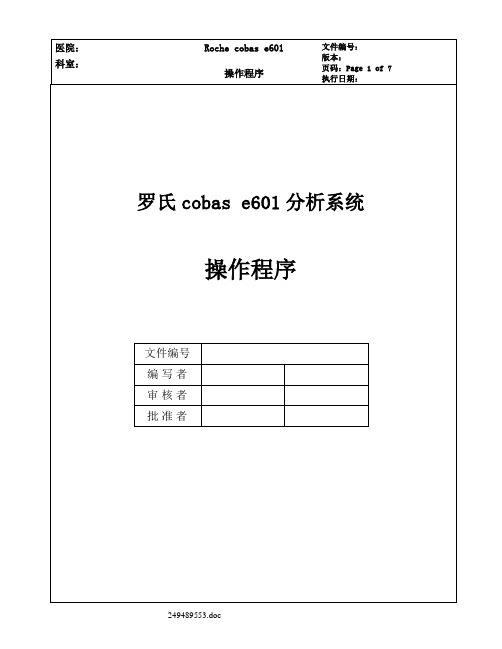
操作程序执行日期:5.3.2在操作中一定要穿戴防护设备。
戴着防护手套工作时应格外当心,因为防护手套易被刺穿或割破,从而导致感染。
5.4废物的处理5.4.1废水的处理.需添加消毒剂,严格按照生物废物处理办法处理。
5.4.2接触人源性样本会造成感染。
所有与人源性样本关联的物质和机械组件均具有潜在的生物危险。
如果样本溶液接触到您的皮肤,应立即用水清洗并使用消毒剂,咨询医生。
6 开机程序6.1开机检查检查供水、排水系统是否正常,供电是否正常,仪器标本是否存在阻碍物。
6.2关机状态6.2.1接通仪器左前方绿色操作电源开关,后打开控制电脑。
电源开关6.2.2仪器开始初始化,输入用户名及密码,登陆仪器操作界面,仪器可以自动关联保养,做完保养后仪器回到后Stand by 状态。
仪器处于休眠状态仪器在进入睡眠时指定的时间自动唤醒,或手动开机唤醒仪器。
系统结束睡眠状态至登录界面,输入用户名及密码,仪器初始化Stand by 状态。
开机后确认system overview,点击Daily Maintenance按键,检查保养工作是否完成(仪操作程序执行日期:9.1.2 擦洗仪器表面(亦可在关机后直接擦洗)Start-- Masking选择模块—OK--Yes,用消毒水擦拭Mask状态的仪器表面,完成后解除模块的Mask。
9.1.3 结束维护保养Utility —Maintenance —32.Finalization- Select,点Execute,仪器自动执行,保养完毕,自动回到Standby。
9.2 关机仪器在进行完保养后自动回到standy by ,点击shut down--shut down 等待操作电脑关机,后将分析仪左侧操作开关关闭。
10. 编工作单10.1 编辑工作单(条形码模式)如使用LIS双向通讯:对于有条码信息的标本,无需编辑,只要将标本放入进样区,点击start-star即可。
10.2 编辑标本(单向通讯模式)进入Workplace—Test Selection10.2.1 单个标本在sample栏选Routine,在type栏选择标本类型,在Sequence No.输入标本号(如需稀释,在S.Vol/D.Ratil 栏选择稀释倍数),选择项目后SAVE,启动Start,在相应的标本操作程序执行日期:类型里输入该标本号,点Start开始检测。
cobas-e-601电化学发光免疫分析仪
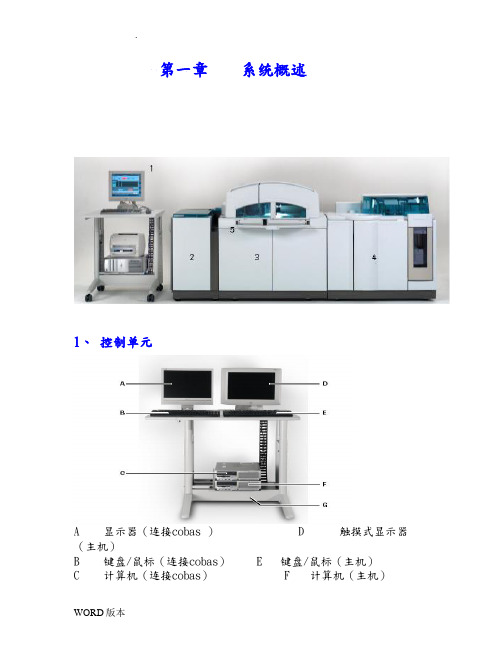
第一章系统概述1、控制单元A 显示器(连接cobas ) D 触摸式显示器(主机)B 键盘/鼠标(连接cobas) E 键盘/鼠标(主机)C 计算机(连接cobas) F 计算机(主机)G 人体学PC支架2、核心单元1)核心单元轨道A 核心单元E 模块轨道B 急诊标本位F 常规标本上机位C 条形码阅读器 G 标本退出位D 标本架转盘急诊标本位A 标本架托盘B 标本架C 标本杯、微量杯2)标本架及标本容器标本架不同类型、颜色和相应编号如下:标本架类型标本架颜色标本架ID号软件中显示标本架上标签常规标本架灰色5001-8999 001-3999 001-3999 STAT标本架红色4001-4999 E001-E999 S001-S999 定标标本架黑色2001-2999 S001-S999 C001-C999 QC标本架白色3001-3999 C001-C999 Q001-Q999 保养标本架绿色B999 B999 W999标本容器有三种类型:标本试管、标本杯、定标及质控小瓶标本试管直径为13mm或16mm,长度为75mm或100mm;标本杯可插入16 mm标本试管中用。
A 标本架上的标本杯 D 16mm×100mm试管B 16mm×75mm试管 E 16mm×100mm试管上的标本杯C 16mm×75mm试管上标本杯3、cobas e 601免疫分析模块e 601模块主要部件如下:A 预清洗区 C 测量区 E 系统试剂区(在前门后面)B 试剂区 D 耗品区B 试剂区各部件A 试剂盘 D 磁珠搅拌棒 F 试剂针B 条件码阅读器 E 磁珠搅拌棒冲洗站 G 试剂针冲洗站C 试剂盖开/关 H 探针清洗站I 试剂注射器C 测量区各部件A 标本针 E 标本注射器B 孵育盘 F sipper注射器C sipper针D sipper冲洗站D 耗品区A 抓手 E TIP/CUP 盒升降器B 涡流混合站 F TIP/CUP 丢弃袋C TIP/CUP G TIP/CUP 盒丢弃区D 指示灯指示器灯“亮”时抽屉可安全打开指示器灯“灭”时抽屉严禁打开E 系统试剂区PrecleanProcellcleancell当更换三种系统试剂的任一种时,长按相对应的绿色按键第二章 软件系统简介1、系统状态概览2、日常工作菜单工作区试剂定标质控应用设定停止关机停止吸样报警打印开始系统状态概览仪器状态操作者日期时间第三章基本操作1、开机a 、检查供水、排水系统是否正常,打开供水系统电源b 、接通仪器左侧电源开关A 标本架上机/退出区 C 电源开关B 急诊标本位 D 主开关电路断路器c 、登陆输入用户名及密码,仪器初始化后进入Stand by 状态注意:仪器分不同级别及权限使用,可根据实际情况设定;添加用户名后,第一次输入的密码即为以后的密码。
罗氏E601 电化学发光免疫分析仪双向通讯软件的的开发
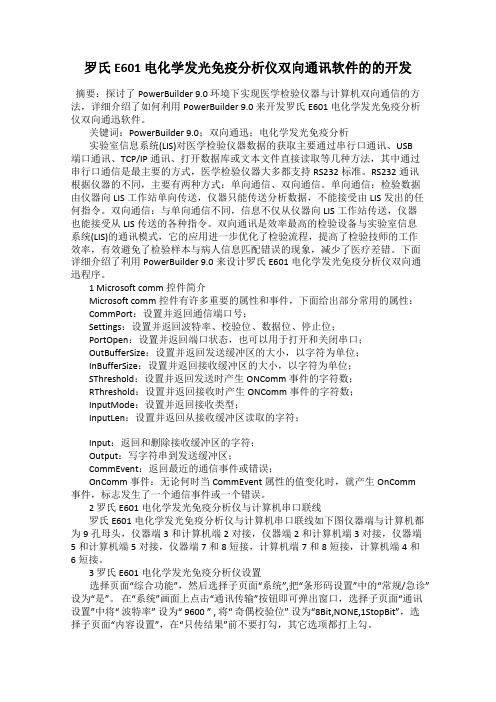
罗氏E601 电化学发光免疫分析仪双向通讯软件的的开发摘要:探讨了PowerBuilder 9.0 环境下实现医学检验仪器与计算机双向通信的方法,详细介绍了如何利用PowerBuilder 9.0 来开发罗氏E601 电化学发光免疫分析仪双向通迅软件。
关键词:PowerBuilder 9.0;双向通迅;电化学发光免疫分析实验室信息系统(LIS)对医学检验仪器数据的获取主要通过串行口通讯、USB端口通讯、TCP/IP通讯、打开数据库或文本文件直接读取等几种方法,其中通过串行口通信是最主要的方式,医学检验仪器大多都支持RS232标准。
RS232通讯根据仪器的不同,主要有两种方式:单向通信、双向通信。
单向通信:检验数据由仪器向LIS工作站单向传送,仪器只能传送分析数据,不能接受由LIS发出的任何指令。
双向通信:与单向通信不同,信息不仅从仪器向LIS工作站传送,仪器也能接受从LIS传送的各种指令。
双向通讯是效率最高的检验设备与实验室信息系统(LIS)的通讯模式,它的应用进一步优化了检验流程,提高了检验技师的工作效率,有效避免了检验样本与病人信息匹配错误的现象,减少了医疗差错。
下面详细介绍了利用PowerBuilder 9.0来设计罗氏E601电化学发光免疫分析仪双向通迅程序。
1 Microsoft comm控件简介Microsoft comm控件有许多重要的属性和事件,下面给出部分常用的属性: CommPort:设置并返回通信端口号;Settings:设置并返回波特率、校验位、数据位、停止位;PortOpen:设置并返回端口状态,也可以用于打开和关闭串口;OutBufferSize:设置并返回发送缓冲区的大小,以字符为单位;InBufferSize:设置并返回接收缓冲区的大小,以字符为单位;SThreshold:设置并返回发送时产生ONComm 事件的字符数;RThreshold:设置并返回接收时产生ONComm 事件的字符数;InputMode:设置并返回接收类型;InputLen:设置并返回从接收缓冲区读取的字符;Input:返回和删除接收缓冲区的字符;Output:写字符串到发送缓冲区;CommEvent:返回最近的通信事件或错误;OnComm事件:无论何时当CommEvent属性的值变化时,就产生OnComm事件,标志发生了一个通信事件或一个错误。
COS.E601电化学发光

析 临床意义
HCG+β 妊娠后一周HCG浓度就可以判定妊娠。现妊娠无关 的HCG浓度升高见于其它疾病患者,如生殖细胞肿瘤、 卵巢肿瘤、膀胱肿瘤、胰腺肿瘤、胃肿瘤、肺肿瘤和肝 肿瘤。
析 临床意义
促甲状腺素(TSH) 三碘甲状腺原氨酸(T3)
游离三碘甲状腺原氨酸(FT3)
甲状腺素(T4)
游离甲状腺素(FT4)
全自动电化学发光免疫分析 临床意义
雌二醇(Estradiol) 雌二醇是生物活性最强的雌激素,主要由卵巢产生。 血液中游离的E2约为5%,其余的与蛋白质结合而转运。 雌二醇可用于生育治疗中的疗效监测以及体外受孕中排卵 时间的确定。雌二醇测定临床上用于阐明下丘脑-垂体-性 腺轴的生育障碍、男子女性乳房、产生雌激素的卵巢和睾
析 临床意义
糖类抗原199 (CA19-9) CA19-9测定有助于胰腺癌(敏感性70-87%)的鉴别 诊断和病情监测;测定值高低与肿瘤大小无关,但高于 10000U/ml时,几乎均存在外周转移,对于肝胆管癌, CA19-9诊断敏感性为50-75%;对于胃癌,与CA72-4、 CEA联合检测。某些患者轻微的胆汁郁积便可导致
Cobas e 411 全自动电化 学发光免疫分析系统介绍
Cobas e 601 全自动电化学发光免疫分析系统性能特点: 1. 准确度;有与仪器配套的原装试剂、标准品和质控品, 系统完整,具备溯源性,保证了结果的准确,可检测血 清外观功能,可凝块检测及自动重检功能 2.高效率;120个以上测试/小时,可标配样本及试剂条 码阅读器,可离心的样本架,操作方便, 可以不停机连 续装载样本,并可以在运行中装载试剂, 自待机 (STANDBY)到运行(加试剂或样本)仅需9多钟,满 足临床需求。
全自动电化学发光免疫分析 临床意义
- 1、下载文档前请自行甄别文档内容的完整性,平台不提供额外的编辑、内容补充、找答案等附加服务。
- 2、"仅部分预览"的文档,不可在线预览部分如存在完整性等问题,可反馈申请退款(可完整预览的文档不适用该条件!)。
- 3、如文档侵犯您的权益,请联系客服反馈,我们会尽快为您处理(人工客服工作时间:9:00-18:30)。
罗氏E601 电化学发光免疫分析仪双向通讯软件的的开发
发表时间:2016-01-26T14:25:22.000Z 来源:《卫生部公告》2015年9期作者:黄阶胜顾向明李莹莹[导读] 广东省中山市中医院检验科 RS232通讯根据仪器的不同,主要有两种方式:单向通信、双向通信。
(广东省中山市中医院检验科广东中山 528400) 摘要:探讨了PowerBuilder 9.0 环境下实现医学检验仪器与计算机双向通信的方法,详细介绍了如何利用PowerBuilder 9.0 来开发罗氏E601 电化学发光免疫分析仪双向通迅软件。
关键词:PowerBuilder 9.0;双向通迅;电化学发光免疫分析实验室信息系统(LIS)对医学检验仪器数据的获取主要通过串行口通讯、USB端口通讯、TCP/IP通讯、打开数据库或文本文件直接读取等几种方法,其中通过串行口通信是最主要的方式,医学检验仪器大多都支持RS232标准。
RS232通讯根据仪器的不同,主要有两种方式:单向通信、双向通信。
单向通信:检验数据由仪器向LIS工作站单向传送,仪器只能传送分析数据,不能接受由LIS发出的任何指令。
双向通信:与单向通信不同,信息不仅从仪器向LIS工作站传送,仪器也能接受从LIS传送的各种指令。
双向通讯是效率最高的检验设备与实验室信息系统(LIS)的通讯模式,它的应用进一步优化了检验流程,提高了检验技师的工作效率,有效避免了检验样本与病人信息匹配错误的现象,减少了医疗差错。
下面详细介绍了利用PowerBuilder 9.0来设计罗氏E601电化学发光免疫分析仪双向通迅程序。
1 Microsoft comm控件简介
Microsoft comm控件有许多重要的属性和事件,下面给出部分常用的属性: CommPort:设置并返回通信端口号;
Settings:设置并返回波特率、校验位、数据位、停止位; PortOpen:设置并返回端口状态,也可以用于打开和关闭串口; OutBufferSize:设置并返回发送缓冲区的大小,以字符为单位; InBufferSize:设置并返回接收缓冲区的大小,以字符为单位; SThreshold:设置并返回发送时产生ONComm 事件的字符数; RThreshold:设置并返回接收时产生ONComm 事件的字符数; InputMode:设置并返回接收类型;
InputLen:设置并返回从接收缓冲区读取的字符; Input:返回和删除接收缓冲区的字符; Output:写字符串到发送缓冲区;
CommEvent:返回最近的通信事件或错误; OnComm事件:无论何时当CommEvent属性的值变化时,就产生OnComm事件,标志发生了一个通信事件或一个错误。
2 罗氏E601电化学发光免疫分析仪与计算机串口联线
罗氏E601电化学发光免疫分析仪与计算机串口联线如下图仪器端与计算机都为9孔母头,仪器端3和计算机端2对接,仪器端2和计算机端3对接,仪器端5和计算机端5对接,仪器端7和8短接,计算机端7和8短接,计算机端4和6短接。
3 罗氏E601电化学发光免疫分析仪设置
选择页面“综合功能”,然后选择子页面“系统”,把“条形码设置”中的“常规/急诊”设为“是”。
在“系统”画面上点击“通讯传输”按钮即可弹出窗口,选择子页面“通讯设置”中将“ 波特率” 设为“ 9600 ” , 将“ 奇偶校验位” 设为“8Bit,NONE,1StopBit”,选择子页面“内容设置”,在“只传结果”前不要打勾,其它选项都打上勾。
4 双向通讯主要代码
本双向通信程序由PowerBuilder 9.0软件编写, 在通信窗口中插入mscomm32.ocx通信控件,控件名为ole_mscomm。
初始化程序放在窗口的open()事件中。
窗口的open()事件程序主要如下: ole_mport = 1 //设置通信端口号为com1ole_mscomm.object.settings = “ 9600,n,8,1 ” // 波特率为9600bps,无奇偶校验,8 位数据位,1位停止位。
if ole_mscomm.object.portopen = false then ole_mscomm.object.portopen = true //打开串口timer(5) 数据处理放在窗口的timer()事件中。
窗口的timer()事件程序主要如下: string ls_inputdata //读取的数据
Boolean ib_iseot = false
string is_enq = char(5), is_ack = char(6) string is_buffer, is_send, ls_sendxm
integer is_number, i,li_inputdatalens, li_pos ls_inputdata = ole_mscomm.object.input
li_inputdatalens = len(ls_inputdata)
for i = 1 to li_inputdatalens
choose case mid(ls_inputdata,i,1)
case char(0) ,char(2) ,char(10) //过滤case char(1)
ib_iseot = false //初始化
ole_mscomm.object.output = is_ack //应答ackcase char(3),char(5)
ole_mscomm.object.output = is_ack //应答ackcase char(4)
is_buffer = is_buffer + char(4)
ole_mscomm.object.output = is_enq //应答enqcase char(6)
if ib_iseot = false then
is_buffer = is_buffer + char(6)
li_pos = pos(is_send,';')
if li_pos > 0 then
if is_number = 2 then
ls_sendxm = mid(is_send,li_pos + 1,Len(is_send) - li_pos)
ole_mscomm.object.output = ls_sendxm //向仪器发送测试指令
ib_iseot = trueend if
if is_number = 1 then
ls_sendxm = mid(is_send,1,li_pos - 1)
ole_mscomm.object.output = ls_sendxm //向仪器发送测试指令
is_number = is_number + 1end ifelse
ls_senddata = is_send
ole_mscomm.object.output = ls_sendxm //向仪器发送测试指令
ib_iseot = trueend ifelse
ole_mscomm.object.output = is_eot
ib_iseot = falseend ifcase char(13)
if len(is_buffer) > 2 then
if mid(is_buffer,len(is_buffer) - 2,1) <> char(23) then
this.wf_data(is_buffer) //结果数据处理
is_buffer = ''end ifelse
is_buffer = ''end ifcase char(23) //eot
is_buffer = is_buffer + char(23)
ole_mscomm.object.output = is_ack //应答case else
is_buffer = is_buffer + mid(ls_inputdata,i,1)end choosenext
5 讨论
本文通过一具体的例子分步骤介绍了如何在PowerBuilder环境下利用通讯控件MSComm控件来开发罗氏E601电化学发光免疫分析仪双向通信软件。
掌握了以上基本技术,就可以稍加改变来开发罗氏C501全自动生化分析仪等罗氏仪器双向通信软件。
参考文献:
[1] 朱有存,白青伟,杨晓荣,等.利用Mscomm32控件实现检验仪器联机[J].医疗卫生装备,2008,29(6):55-56.
[2] 何军,曲炜.PowerSeript 语言、事件与函数大全[M].北京:电子工业出版社,2000.。
